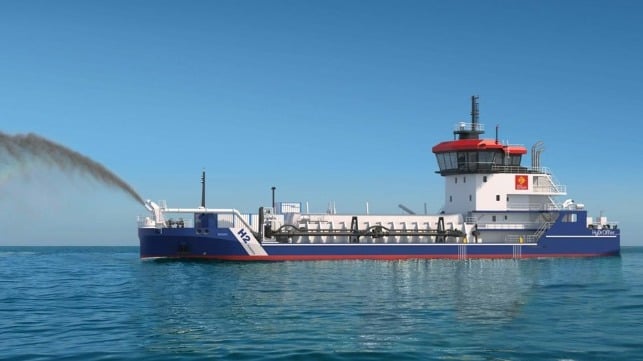PIRIOU to Build First Airlift Dredger with Hydrogen Fuel Cell

French shipbuilder PIRIOU has received an order for a new airlift dredger, which will also be the first vessel of its kind to be equipped with a hydrogen fuel cell. Due to be delivered in the third quarter of 2023, the new dredger will not only be a highly productive vessel, but it also introduces new environmental and efficiency benefits with its fuel cell system while also being sensitive to the areas in which it operates.
“In obtaining this new contract, we are happy we won the trust of a new Region, the Occitanie Region of south France, and for them, we will realize an innovative and complex vessel able to answer the requirements of very demanding operating conditions and optimum comfort for its crew,” said Vincent Faujour, PIRIOU group C.E.O.
He noted that integrating a fuel cell, batteries, and hydrogen storage containers on a dredger is a technological challenge that the company looks forward to as part of the effort to develop the French marine hydrogen sector.
Designed in collaboration with Toulouse LMG Marin naval architect firm, the new vessel incorporates features to make it an environmentally friendly dredger. It will be equipped with IMO 3 engines to meet the latest environmental standards. Whether docked or at anchor, and to limit noise and environmental pollution, the vessel will be able to be powered entirely by its fuel cell. The available power will be sufficient to allow the crew to carry out their work onboard without needing a generator. Whether at berth or in operation, particular attention has been paid to reducing air and water noise pollution.
PIRIOU estimates that the integration of a hydrogen fuel cell will save up to 20 percent on the vessel’s fuel consumption. “Thanks to its low environmental impact, this future dredger will participate in the energy transition undertaken in the merchant marine sector,” said Faujour.
The contract for the construction of the 230-foot dredger for the Occitanie Region was awarded after an international competition that was conducted over the past year and a half. The vessel, which is scheduled for delivery in the third quarter of 2023, will be dedicated to the maintenance of harbors in the Gulf of Lion.
In addition to the hydrogen fuel cell system, it will feature other modern design advancements. It will have a capacity to transport up to 1500 m3 of sediments and will be fitted with a 500 mm diameter sling to collect sand at a depth up to 32m and a front unloading device used to replenish beaches. It will have the capability to suck up the sediment with a 6000 m3/hour pump driven by a variable-speed electric motor. Its pumping capacity allows the well to be filled in less than 20 minutes, while sediments removed from the harbors are discharged by lapping through doors located at the bottom of the hull.
In addition to having 50 percent more capacity than the former Cap Croisette dredger, the new vessel will be equipped with a set of three variable-speed electric thrusters (two 360° steerable thrusters at the stern and a high-powered bow thruster) to make it highly maneuverable essential for dredging harbor channels.
Main characteristics for the air suction dredger
Length: 70.0 m
Breadth: 13.6 m
Depth at main deck: 5.3 m
Max. draft: 4.45 m Crew accommodation: 14 p
Max. speed: 11 kn
Hull / superstructure: steel
Steerable thrusters: 2 x 700 kW
Bow thruster 1 x 480 kW
Power plant (4 GE + H2 cell): 2 500 kW
Deadweight: 2 110 T
Well capacity: 1 500 m3
Fore deck capacity: 4 x 20’ H2 containers
Dredging depth: 32 m
Dredge pump: 6 000 m3/h / 700 kW
